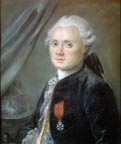
Charles Messier, 1730 to 1817
“When amateurs get tired of observing the Moon and Planets, they often start to search for fainter things like galaxies, nebulae and clusters of stars listed in the very first catalogue of these objects compiled over 200 years ago by the Frenchman Charles Messier. Everyone has seen pictures of these objects for they represent the biggest, brightest and best of the lot.”

Charles Messier, 1730 to 1817
M-object Catalogue of Charles Messier
The most popular catalogue of celestial objects (clusters of stars, nebulae and galaxies) was compiled by Frenchman Charles Messier (1730–1817) in the late 1700s. This catalogue was the very first of its kind and it is still widely used today by amateurs and professional astronomers. Its listing of 110 Deep Sky Objects (see definition and discussion of Deep Sky Objects farther below) represent the biggest and brightest visible from the northern hemisphere. All of these objects can be seen with a telescope as small as 3 inches in diameter.
M-objects & List. In astronomy circles, whenever you hear someone say the letter “M,” followed by a number from 1 to 110, it refers to an object in the Messier catalogue. Included are the Great Orion Nebula (M42), Pleiades (M45), Great Hercules Cluster (M13), Ring Nebula (M57) and many more. It just so happens that at least one of every type of deep sky object is represented in this catalogue. CLICK HERE for a list of all the Messier objects.
History. Charles Messier was a comet hunter who started cataloging fuzzy appearing objects in order to avoid mistaking them for comets, but soon expended the catalog to deep sky objects in general. CLICK HERE for a short history of Charles Messier.
Messier Marathon. All of the Messier objects can be seen with a small telescope, and a few can even be seen with the naked eyes. Many can be glimpsed with binoculars. Once a year, around the New Moon in March, it is possible to see all but one of these objects in a single night. This is commonly called the Messier Marathon. More information and checkoff list are provided below.
General info about the Messier Marathon
List of all the Messier Objects
Abbreviated Checkoff list for Messier Marathon
Detailed Checkoff list for Messier Marathon
Chart showing all the objects
Deep Sky Objects (DSO)
Deep Sky Objects include nebulae, planetary nebulae, supernova remnants, star clusters, globular clusters and galaxies, that is, distant objects beyond our solar system. Stars are not considered deep sky objects.
Galaxies
Galaxies represent groupings of billions of stars. All galaxies lie outside our Milky Way Galaxy at distances in the millions to billions of light years. The most distinct looking galaxies are categorized as “spiral,” which have several curved arms radiating from a bulged center or nucleus. However, by far the most common galaxy is the elliptical which resembles a ball or elongated ball. There are also irregularly shaped galaxies with “mixed-up” insides. Galaxies are faint and appear brightest in larger amateur telescopes. The most well-known, and one of the few that can be seen with the naked eye, is the Andromeda Galaxy, M31. Galaxies do not show much detail in small or large telescopes. They are generally faint and diffused, no matter the size of the telescope. Galaxies appear their best in photographs.
Nebulae
The word nebulae is a general term that refers to gaseous hydrogen clouds. These clouds reside inside galaxies. For the most part, amateurs and professional astronomers can observe only the closest nebulae, those in our Milky Way Galaxy.
There are several types of nebulae: galactic clouds, planetary nebulae and supernova remnants. Galactic clouds represent birthing places of stars. They can appear dark, like silhouettes or bluish/reddish in color because they either reflect starlight or create their own light. These nebulae are located mostly in the arms of our Milky Way Galaxy. The best example is the Great Orion Nebula, M42. Planetary nebulae (the name has nothing to do with the planets, it's just an old name that stuck) represent the remains of outer atmospheres from “large” stars in their death throes. These nebulae are spherical, ringed or have diametrically opposed lobes. The best example is the Ring Nebula,. Supernova remnants are nebulae created from the explosions of very large stars at the ends of their lives. M1 is a good example. Supernova remnants are rare compared to other nebulae. On the average, nebulae are faint and appear best in larger amateur telescopes. However, there are a handful that are magnificent even in small telescopes. One of the best is the Orion Nebula (M42).
Star clusters
The term “star cluster” is a general term referring to an open cluster or globular cluster. An open cluster represents a group of stars born together out of the same nebula, anywhere from a dozen to a thousand. Globular clusters are distinctly different from open clusters, being a collection of several thousand to a million stars compacted into the shape of a ball. Our galaxy has about 200 globular clusters surrounding it in a spherical halo. In small telescopes, open clusters appear better than in most photographs. They are much easier to observe than nebulae and galaxies. More than any other heavenly object, globular clusters really come "alive" in larger telescopes (12-inches in diameter plus), and more than you would think from viewing them in smaller telescopes.